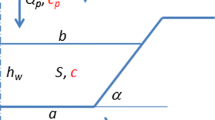Abstract
The effects of supplemental irrigation, sand columns and blocked furrows on soil water distribution and barley yield were studied on arid soils affected by surface crusts. The sand columns were 50 mm diameter, 600 mm deep, and filled with sand of 0.375 mm mean diameter. The blocked furrows were trenches about 250 mm deep, 300 mm wide, and 6 m long established perpendicular to the slope direction. Sand column and furrow treatments significantly increased soil water storage compared with natural or control treatments. Soil water storage significantly increased by about 210% and 230% near the center of the sand column and the furrow treatments, respectively, relative to the control treatment. For sand column treatments, soil water storage decreased linearly with distance from the center of the sand column to about 2.5 m, while for the furrow treatment soil water storage decreased logarithmically to a distance of about 1.0 m, beyond which the soil water storage was not significantly different from the natural or control treatments. The furrow and sand column treatments significantly increased the water application efficiency, seasonal consumptive use and barley grain and straw yields compared with natural and control treatments. Increasing furrow spacing increased the catchment area and consequently crop production per furrow, but decreased crop production per unit total (cultivated and catchment) area. Decreasing sand column spacing reduced surface runoff and increased soil water storage and consequently barley grain and straw yields. Supplemental irrigation is essential for grain production in limited rainfall areas. Soil management is also required to overcome the problems of the soil surface crusting and the low permeability of subsurface soil layers for maximum rainwater efficiency, and for optimal crop production with minimum supplemental irrigation water. Where agricultural land is not limited, furrowed soil surfaces appear to be the most suitable technique for barley grain production. Sand columns with sprinkler irrigation might be more suitable for growing barley as forage crop where agricultural land is limited.
Similar content being viewed by others
Author information
Authors and Affiliations
Additional information
Received: 19 October 1998
Rights and permissions
About this article
Cite this article
Abu-Awwad, A. Effects of sand column, furrow and supplemental irrigation on agricultural production in an arid environment. Irrig Sci 18, 191–197 (1999). https://doi.org/10.1007/s002710050062
Issue Date:
DOI: https://doi.org/10.1007/s002710050062




